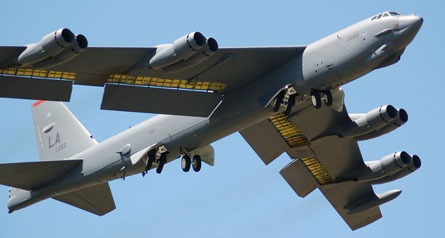The US Air Force has revived a plan to transform a portion of the Boeing B-52 bomber fleet into long-range, radar-jamming platforms, formally launching a five-year study phase on 23 June.
The revival comes nearly three years after the USAF was forced to cancel the B-52 stand-off jammer system (SOJS) programme after cost estimates ballooned sevenfold to $7 billion. The delay has shifted the operational debut of the new jammer fleet at least four years to 2018.
The new programme seeks to hold overall costs to about $3 billion or $4 billion by scaling back the jamming requirements and reducing the number of B-52s involved.
 |
|---|
The SOJS programme was cancelled after requirements grew to target all emitter threats in the low and middle bands of the electromagnetic spectrum.
The new programme continues to focus on the early warning radars that fall mostly in the low band, but is aimed at only a subset of the potential threats in the middle band, says Jeff Weis, Boeing's programme manager for airborne electronic attack technology maturation.
The numbers of B-52s expected to be modified has shrunk from the entire bomber force to 34 aircraft, Weis says. Also, the USAF also plans to buy only 24 sets of wingtip pods during the programme, he adds, so only two dozen B-52s would be able to perform the mission at any one time.
The USAF plans to spend $68 million over the next five years to improve the technical maturity of the contracts involved. On 23 June, Boeing received a contract worth nearly $15 million to complete aircraft integration studies for new phased-array pods called core component jammers (CCJ) and advanced exciters.
Northrop Grumman's Integrated Systems division, Boeing's previous competitor for the original SOJS contract, is now Boeing's subcontractor.
Potential suppliers for the CCJ - EDO, ITT, Northrop's Electronic Systems division and Raytheon - are being awarded separate contracts to develop the new jamming systems.
The USAF is launching the revived programme with support from the US Navy, which plans to develop a new phased-array called the next-generation jammer to replace the analogue ALQ-99.
Source: Flight International



















